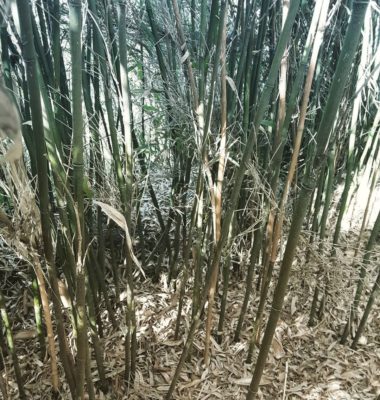Give Native Problem-Solver Giant River Cane A Chance

Let’s meet a plant that offers many natural solutions to some of our un-naturally made problems: the Giant River Cane (Arundinaria gigantea).
It’s one of our state’s three native bamboos, of which one other can be found in Transylvania County.
Giant River Cane, like a lot of other plants and animals, were once much more abundant.
There’s a really long arc of time from pre-European contact use, to exploitative over-grazing, to haphazardly altering our waterways and wetlands, to modern expansive development— but this plant has managed to hold out, clinging to thin slivers of riverbanks here and there throughout the mountains. And that’s a very good thing, not just for the plant, but for us too. Giant River Cane can be a hard-working problem solver in several ways.
Sediment is the number one non-point source pollutant in our state’s waterways. It makes our water bills higher, it can ruin fisheries, and of course all the living things in rivers just can’t get up and walk out. Sediment can devastate living webs of creatures.
But Giant River Cane can help, with its winding mats of roots (called rhizomes) cane holds soil tight. Large stands of Cane called Canebreaks are also able to absorb and use loads of sediment as they flood in.
Unlike trees, which are also great at holding banks, River Cane is much more flexible. Being a faster grower, it can respond to more immediate changes from sediment deposition, pulling itself to the right depth in the soil. It can also occupy new cuts much quicker preventing further soil loss.
Giant River Cane has also shown in studies to be an excellent mitigator of agricultural run-off. Whether it be manures or over-fertilizing, Canebreaks can take up significant amounts of those nutrients. When kept from waterways, heavy nutrient loads cannot create algal blooms, or create spikes in fecal coliform measurements.
But isn’t bamboo invasive? If I drop it on the ground, should I run? Let’s draw a big difference between our native bamboo and the one you’re probably thinking of, the Yellow Bamboo (Phyllostachys).
You’ve seen Yellow Bamboo everywhere, sometimes it still gets planted, but most seem to agree— it’s a very problematic plant. It grows anywhere, and everywhere in all directions. and it causes trouble, binding up water and sewer lines, pushing out all other plants, and can drink streams dry.
Giant River Cane has evolved over Deep Time to fit cooperatively into its ecosystem, relegated to riparian areas with sandy soils. Giant River Cane supports other Life forms, rather than pushing all else out.
I’d ask you to reconsider this plant, to get to know all the right reasons to boost its presence on the banks of our waterways. With more Cane on the landscape, we will all benefit.
Torry Nergart is an avid adventurer, a local Brevard dad and spouse, and just happens to be conservation easement manager for Conserving Carolina, a calling that often puts him in a climbing harness, or waders, on a bike, or, yes, in a kayak, too, to protect the land and water we all love.